
|
Olympus Camedia C-5060WZ Image Samples |

| My other pages related to the Olympus C-5050Z, C-5060WZ, and X-7070WZ |
|
Here are some sample images I took during my first week with the '5060 (November, 2003), as well as some shot later, in 2004. The pictures at the left are full frames, reduced to 360x270 pixels and resharpened. They are included to show the location and relative size of the 1:1 samples, which are shown at the right. The 360x270 samples are pieces of unmanipulated originals, cropped and re-saved at a low JPEG compression, so that they can be representative as to the "original" image quality. The samples look larger on your screen than when printed (unless you are reading this page on a PDA). For 8x10" prints, the sample height will correspond to 1.14" (29 mm) on paper, while for 11x14" ones — to 1.57" (40 mm). All were shot with contrast, sharpness, and saturation at "Normal", unless explicitly stated otherwise. If in doubt, you may check the embedded EXIF information, which has been preserved. Outdoors, overcast This is a low-contrast scene, and contrast often affects our subjective feeling of sharpness. Keeping that in mind and looking close at the contour sharpness we may see that samples are as sharp (or maybe almost as sharp) as those from the '5050. I may take the "almost" out when I have more experience with the camera. First, let us see how zoom performs at the widest setting, as this is the tough part when designing a wide-range, wide-angle zoom. This is my primary sample scene: a view across the lake in front of my house. | ||
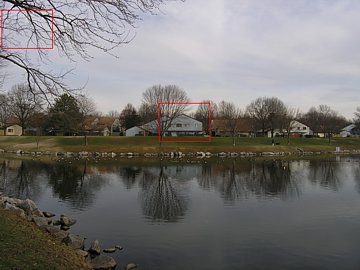
|
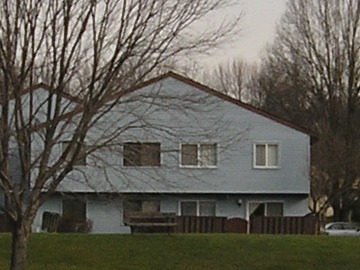
| |
| EFL=27mm (F=5.7 mm), program mode, no exposure compensation (1/640s, F/4.0), compression 1:4, no tripod. | ||
|
The sample from the top-left of the frame, shown here, exhibits some chromatic aberration: some stray, colored light spilling from highlights into shadows: usually magenta outwards from the center, and green towards it (sometimes the opposite; depends how the lens is corrected).
(A somewhat similar effect, purple fringing, usually demonstrates itself as a magenta spill in all directions out of a bright area. I haven't seen that in the '5060.) Clearly, the vertically-running branch at the very left has a green fringe at the left, and purple — on the right. The width of the color fringe is, however, small: maybe two pixels, which is usually considered very good or better. |
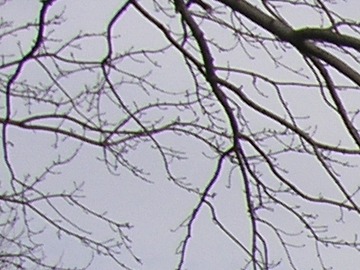
| |
|
Now the other extreme, at the longest zoom setting, with a picture taken within a minute from the previous one. | ||
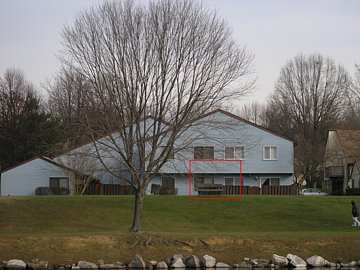
|
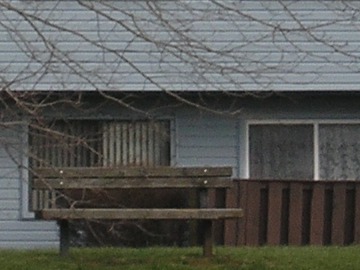
| |
| EFL=110 mm (F=22.9 mm), program mode, no exposure compensation (1/320s, F/4.8), compression 1:4, no tripod. | ||
|
Not surprisingly, at this focal length I was not able to see any chromatic aberration in the branches (so I am not even showing any peripheral crop here). Note, however, what I consider excessive sharpening: a white "bounce" above the dark bench, especially visible on the background of the house siding. This might be OK in a mass-market camera, where it would not be visible in postcard-sized prints (even generating some illusion of sharpness) — but in a top-drawer model? Well, I'm keeping my sharpness setting at -3 or lower, period. Outdoors, diffused bright light The same scene, shot on another evening, just before the sunset. | ||
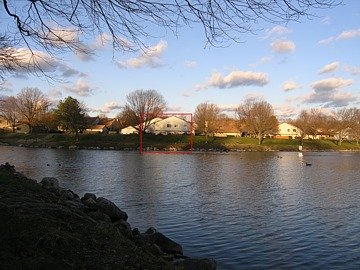
|
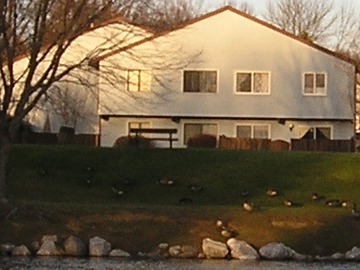
| |
|
EFL=27mm (F=5.7 mm), program mode, no exposure compensation (1/250s, F/4.0), compression 1:4, tripod. | ||
|
Let me note that this is a difficult scene to meter, with great tonal range between the dark background and the bright house in the center. The camera's matrix metering did an exemplary job here, squeezing as much as it could into the 8 bits/color JPEG format limits. Actually, this is where the ORF raw format might come handy: with more bits per color it would preserve more detail in the shadows, which then could have been enhanced in postprocessing before fitting the image again into JPEG constraints. This would, however, involve manipulation of image tonality, as our computer screens are not able to show more than eight bits per color, so the exercise would lose its intended sense. Now, the same scene at the longest zoom setting. | ||
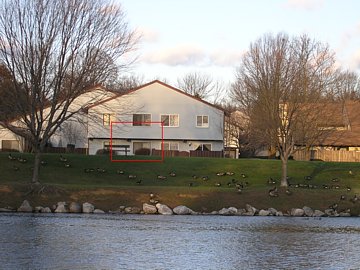
|
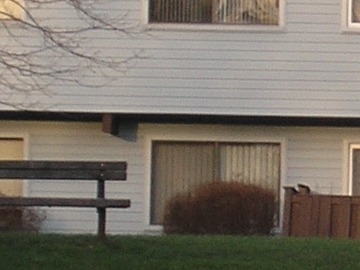
| |
|
EFL=110 mm (F=22.9 mm); program mode, no exposure compensation (1/100s at F/4.8, ISO 86). Yes, the ISO 86 is reported in the EXIF information; obviously this is where the program decides to start raising the CCD gain! | ||
|
Note, again, excessive sharpening at the top of the bench and at the protrusion above the first floor. The image tonality is, again, on the spot or very close. Outdoors, full sunlight at noon The new ferry terminal in Cape May, New Jersey: good detail, sharpening seems acceptable; my chosen exposure compensation seems maybe a tad too much. | ||
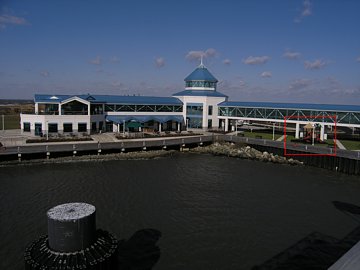
|
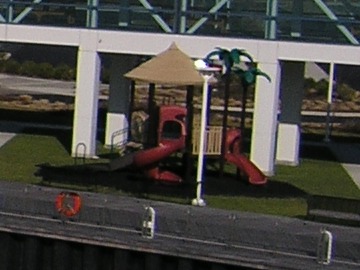
| |
|
EFL=27 mm (F=5.7 mm); program mode with -0.7 EV compensation (1/1000s at F/4 and ISO 80). | ||
|
Outdoors, fill-in flash before sunset This one was shot late May afternoon, about 6:30 PM, with the Sun obscured by light clouds. For the fill-in flash I have used the Olympus FL-40 with the LumiQuest ProMax diffuser. This is, like always, a straight sample, no image adjustments. | ||
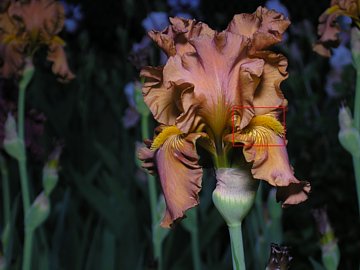
|
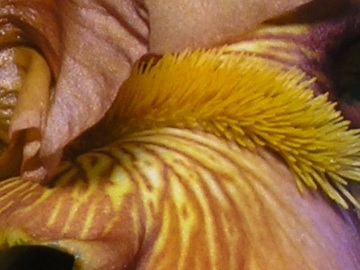
| |
|
EFL=110 mm (F=22.9 mm); program mode with -0.3 EV compensation (1/100s at F/4.8 and ISO 80); FL-40 flash with LumiQuest diffuser, handheld. Contrast and sharpness at -2, saturation at +1. | ||
|
You may see this and a few more examples from that session in my Jane's Irises Gallery page. While those have been postprocessed (just slightly, just tonal scale adjustment), they should give you a good idea about this camera's close-up capabilities. Indoors flash The next sample shows how the '5060 works with the Olympus FL-40 flash unit, using bounce flash in close quarters. There was no external light (incandescent, fluorescent, or daylight), and the camera used two focus-aid beams (its own and the one on the FL) to get the focus under adverse conditions, quite successfully. The skin tones are also natural and pleasing. | ||
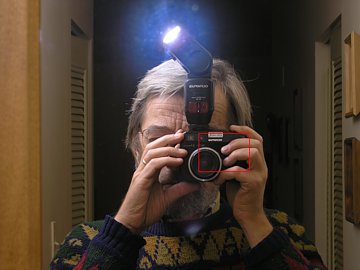
|
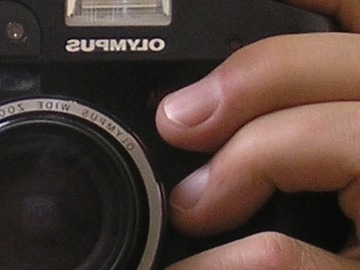
| |
| EFL=99 mm (F=20.7 mm), program exposure with -0.3 EV flash compensation: 1/80 s at F/4.5, auto ISO at 100. | ||
|
Another one, this time taxing the Olympus white balance algorithms: mixed light is very difficult, and in this case we have a mix of the flash light, fluorescent one over the counter, and a number of incandescent sources. Depending on the location, different areas will have a different color cast, a tough cookie. | ||
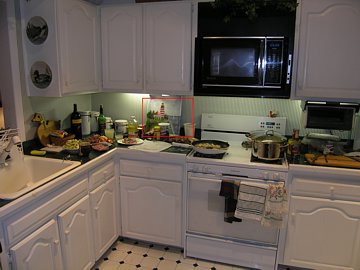
|
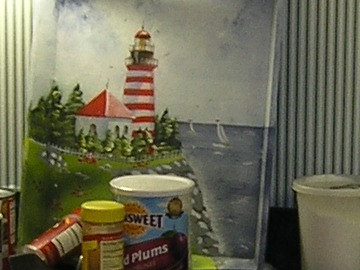
| |
| EFL=27 mm (F=5.7 mm), program exposure with the built-in flash: no compensation, 1/30s at F/2.8 and ISO 100. | ||
|
Indeed, the area above the counter top is fluorescent-greenish, and white cabinets show the mix of red (incandescent) and blue (flash), but this is where the buck stops: without masking individual areas and correcting their color separately I don't think anything better is possible. Macro mode, incandescent light I bought this Soviet-made watch thirty-five years ago in Poland, and it went dead in the early Eighties. Since then, it is used exclusively as a macro shot prop, and it happens to be just the right size for the camera's macro mode (to which Olympus refers as "super macro"). | ||
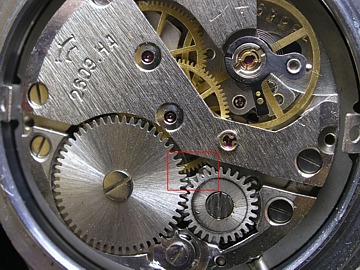
|
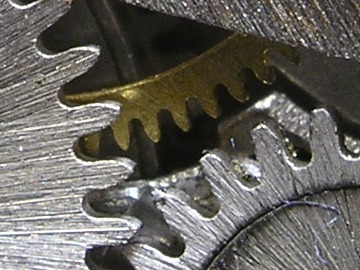
| |
| EFL=55 mm (F=11.5 mm), aperture priority with no compensation: 1 s at F/5.6, white balance by reference. Light source: a single nightstand lamp in a paper shade. | ||
|
The field of vision is just below 29 mm across, which is close to the 28 mm claimed by the manufacturer, and the macro performance of the lens is, in my book, just amazing. I have used a relatively small aperture (large F-number) of F/5.6 to have enough the depth-of-field to cover any inaccuracies in setting the watch surface parallel to the image plane. At these distances F/5.6 seems like a reasonable value anyway. Both the automatic white balance setting and the incandescent preset resulted in quite disappointing color; after resorting to the "one touch" reference mode (measured off a sheet of white paper) the colors just snapped to where they should be. I am pleased to report that both the macro mode and reference white balance setting are as good in the '5060 as they were in the '5050, i.e., outstanding. Conclusion This is a serious camera, and it delivers. I may refine some of the qualitative results shown here, replace or add some samples, but I am already sure it's a keeper, capable of results as good as those of the C-5050Z, and this is a lot. | ||

| My other pages related to the Olympus C-5050Z, C-5060WZ, and X-7070WZ |
|
Camedia® and Olympus® are registered trademarks of Olympus Corporation.
This page is not sponsored or endorsed by Olympus (or anyone else) and presents solely the views of the author. |
| Home: wrotniak.net | Search this site | Change font size |
| Posted 2003/12/05; last updated 2007/08/13 | Copyright © 2003-2007 by J. Andrzej Wrotniak |